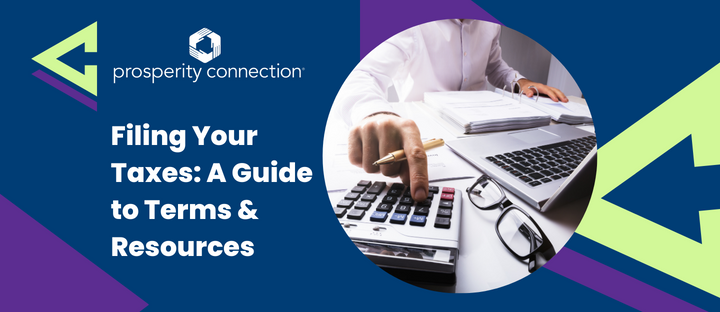Filing your taxes is a complicated process. There are a lot of rules, regulations, and terms that can be confusing. This guide will help you understand the basics of tax terminology and provide some filing resources that can help you navigate the process. Please keep in mind this article is for informational purposes only! Because we are not tax experts, you should not consider anything written here as advice. That said, let’s dive in!
Important terms to know when filing your taxes:
- Adjusted Gross Income (AGI): AGI is all of your income minus certain deductions like student loan interest or contributions to an IRA.
- Deductions & Credits: Deductions reduce your taxable income, while credits are dollar-for-dollar reductions in the taxes you owe; both can help lower your tax bill.
- EITC: Earned Income Tax Credit; a tax credit for working people with low to moderate income. **EITC is a refundable tax credit
- Form 1040: The standard form used for filing federal income tax returns; it lists income sources and deductions for individuals or married couples who file jointly. **There are three types – 1040 (the “Long Form”), 1040A (the “Short Form”), and 1040EZ (the “Easy Form”)
- Form 1099: A form that documents different types of payments made by an individual or a business, typically not your employer. **Rental income or freelance/contract work are common examples
- Form 1095: Health Insurance Marketplace Statement; this form provides information about your insurance policy, your premiums, any advance payment of premium tax credit, and the people in your household covered by the policy.
- Income Exclusion Rule: sets aside certain types of income as non-taxable. Examples include life insurance death benefits, child support, and welfare. **Income that is excluded is not reported anywhere on Form 1040
- Refundable Tax Credit: A type of credit treated as a payment of tax you made during the year. When the total of these credits is greater than the tax you owe, the IRS sends you a tax refund for the difference.
- VITA: Volunteer Income Tax Assistance; provides free tax preparation for low-income, disabled, and elderly members in various U.S. communities.
- W2: Your employer will send you this form every year; it lists wages earned and associated taxes withheld from each paycheck.
What you’ll need when filing your taxes:
- W-2’s and/or 1099-R’s from ALL employers for the previous year
- Interest and dividend statements from banks
- Form 1095—Health Insurance Marketplace Statement
- Social Security cards for all family members OR a Social Security number verification letter issued by the Social Security Administration
- Proof of childcare expenses
- Copy of the previous year’s income tax return (if available)
- Valid picture ID for taxpayer and spouse
- Copy of a check for direct deposit of refund
- Any questions you may have about the preparation process
Services available to help you:
Online Services
In-Person Services
- Volunteer Income Tax Assistance (VITA) Sites
- Gateway EITC Community Coalition
- St. Louis Tax Assistance Program (TAP)
**Please verify which types of tax documents these servicers are trained to prepare by checking the sites above.
Now what?
Finally, if you do qualify for a tax refund this tax season, make sure you use your refund wisely! Tax refunds are a fantastic opportunity to take advantage of an additional lump sum of money. Here are some ideas for your refund:
- Pay off debt
- Open a holiday or special goal savings account
- Set aside money for a down payment
- Take a professional development class or training
- Go on a special trip
- Add to your retirement account
The possibilities are endless! What’s most important is that you use the money in whatever way you need most. And if you’d like some guidance figuring that out, we can help! You can work with one of our financial coaches to make sure your tax refund helps you achieve your financial goals.

